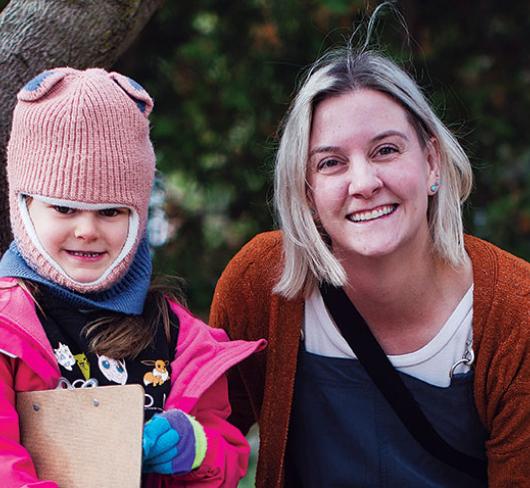
The Telescope, the Teacher and the Tableau (Part of Making Connections: Using the Arts to Teach Literacy)
Using story drama to link language and literacy, social studies, and drama
I love drama. They love pretending. I love reading. They love listening, and interrupting to tell me their thoughts, feelings, and reactions to what I’m reading. I think research skills are great. They think magic is cool. I like inspiring them to write. They like using their pencils as swords. I have a big, big library. They have a crowded portable classroom. Great. Let’s get to fun. Work.
This activity was born out of our desire – the Grade 4 teacher and mine– to create a partnership that will blend drama and research skills, writing skills and a love of literature, art appreciation and their social studies unit on medieval times. And could we also throw in some discussion around character education? We created a story drama unit centred around the beautiful picture book The Spyglass by Richard Paul Evans.
The story drama begins before the story is read, during library time on a March morning. The king strides into the library, wearing a flowing cape over her librarian’s garb, and announces in a grandly affected voice to the audience of 10-year-olds: “I, King So-and-So of the great Western kingdom, do hereby welcome you all to my lands. As my loyal subjects, you all have important roles in the success or failure of my kingdom. But I ask you this: Who are you? What skills do you have? What tools do you require? For I demand that all of my subjects shall be gainfully employed. Thus, I command you, go thither and seek out a job which befits your talents in this our present age, Such-and-Such A.D.”
Removing her cape, the teacher-librarian directs the astonished villagers to the research tables, upon which she has set a variety of books on medieval times. She divides them into groups and instructs them to find and record possible jobs held by medieval commoners, what these jobs entailed, any tools they required, and perhaps where in the village they would find these people.
The villagers return to their classroom with the seeds of their medieval identities and in their journals they reflect: how did they locate the necessary information in the books provided? What did they learn about medieval society as they researched? Was this research task easy or difficult to do?
When they return to the library, the king is waiting. One at a time, they enter into the drama, kneeling before the king and saying, “Sire, I am your humble servant So-and-So, a miller,” or, “Your Majesty, I am Who-and- Who, a dairymaid, at your service.”
The king reveals that the villagers are living in a wealthy, abundant land and that they are to create a drama tableau showing what they would be doing on a normal day in the kingdom. Stepping out of role, the teacher- librarian reminds the students about the rules for good tableaux before they begin: actors are “frozen,” they have a focal point for their eyes, they do not speak, and they use no props. Resuming the role as king, the teacher- librarian then changes the scenario: now the villagers live in an impoverished kingdom. The actors build a second tableau showing their character in such a dismal place.
“Now,” says the teacher-librarian, removing her kingly cape and reaching for a marker, “let’s do a Role on the Wall. Tell me everything you associate with a king.” Adjectives and nouns fly, and the teacher-librarian scribbles furiously to list external things (like gold crowns) outside the king’s profile, and internal qualities (like greed) inside the king’s head. When the board is full, and the students’ creativity complimented, the teacher-librarian smiles at the look of surprise on their faces as she tells them that they are completely wrong: their king is none of these things. And she reaches for the book and reads the first few pages.
Back in the classroom, the teacher uses the first few illustrations to talk about how artists tell their stories on canvas; how mood and atmosphere and character can be revealed by the use of colour. The villagers do an art activity dividing the face of a king into two halves, using bright colours on one half to denote wealth, joy, or happiness, and dull colours on the second half to show quite the opposite. The pictures are beautiful. The villagers proudly sign them – “John Erikson, wool merchant” – and bear them to the library bulletin board.
The villagers run-walk to the library to hear the next part of the story. The teacher-librarian reads a little more, to the point at which the king is given the prophetic spyglass by the old stranger and he sees what his poor kingdom could be. Shutting the book, the teacher-librarian says, “You are not villagers for the moment. You are the voices inside the king’s head – his conscience. You must convince him that he should or shouldn’t share the secrets of the spyglass with his people. Go and brainstorm some ideas, and then we’ll let the king hear them, and he will decide what to do.”
Off they go and their chatter fills the kingdom of the library. After a few minutes, the teacher- librarian calls them back and lines them up in two lines. As the king, back in her robe, walks slowly down the middle, the voices of his conscience give their reasons: “What if one of the villagers steals the spyglass?” “If they don’t see the vision for themselves, how will they trust what the king says?” Turning at the end of the alley, the king thanks them, and says that the decision will be reached the next day.
Back in their class they dive into their response journals. They argue their cases passionately right out into the chilly yard. The next morning, in the schoolyard, some of the villagers spot the king (without her cape but the king nevertheless) and demand to know her decision. “Wait,” the king replies. “All will be revealed.”
Meanwhile, guided by their classroom teacher, they delve back into the non-fiction books to research class structure in the Middle Ages. Poring over the texts, they read aloud to each other the surprising facts about a societal structure so different from our own. First they make graffiti- fact pages; then they organize their information into charts; then they diagram the similarities and differences between the two worlds– worlds which they have learned to straddle with ease.
“Your Majesty, have you reached your decision?” asks the blacksmith, automatically fall- ing into role as he enters the library. “Yes,” the king answers. “As you have heard, I have been entrusted with a great gift. This mystical spyglass has shown me how great our kingdom could be. But we must now ‘make it so.’ I hereby entrust each of you to take the spyglass to your homes, your fields, your barns, your smithies, wherever you live and work within the kingdom. Look carefully at what it reveals to you. In one month’s time, we will convene again, and you will tell us what you have seen, and what you feel we need to do to make it a reality.”
One month (or five minutes) later, the king opens the town hall-style meeting. Each villager takes the floor and the discussion begins. It continues so heatedly that the homeroom teacher cancels Math and lets them roll. The teacher turns this into a writing assignment. The students, writing in role, compose letters to the king, letters full of “thous” and “thines” and “ye shalls.” The letters join the portraits on the library bulletin board.
The book reappears. The fictional king rides out among his people, literally uncovering the potential of the kingdom by pulling weeds from an overgrown garden to reveal a beautiful, forgotten statue. The villagers create three shifting tableaux: one in the garden before the king arrives, the second as the king pulls weeds, and the third when the statue has been revealed. Their body language and their facial expressions show the despair, the disbelief, and the wonder of the scene. The pages come alive; they have joined themselves to the narrative. It is their story now.
But three pages remain unread. The villagers have forgotten that the old man promised to return for the spyglass. The teacher-librarian cannot read without being interrupted: “You can’t give it back!” they shout. With a stern kingly look, the teacher-librarian continues, and the old man reveals the true message of the story: “The spyglass showed what you could be if you believed, for it was only faith that you and your people lacked.”
Donning the royal robe for the final time, the king invites his loyal subjects to line the street leading out of the kingdom, and to give one last message to the stranger who brought them the gift of believing in themselves. The homeroom teacher is the old man, and he walks slowly through these transformed students as they pay homage to him. But for the sound of their young, sincere voices, you can hear a pin drop.
One final journal entry remains: the students reflect on what the story teaches us about initiative and about optimism. Their thoughts are of the highest level: Piaget would be proud.
The villagers rejoice. They learned new things. They grew. They had fun.
They still call me Your Majesty.

